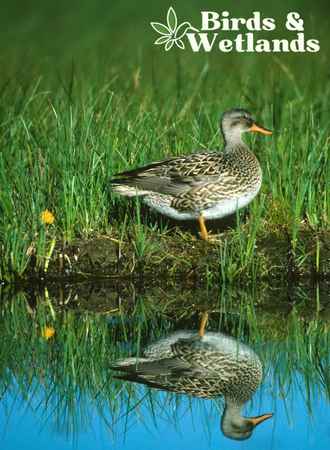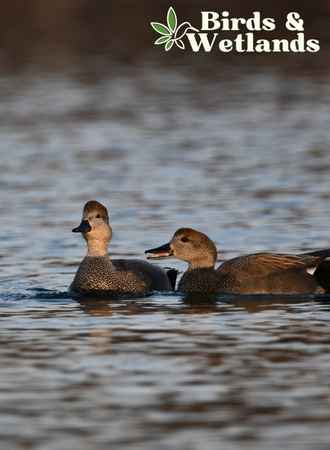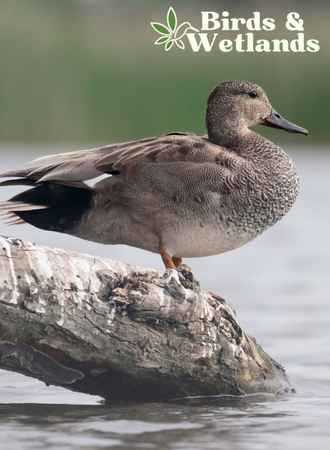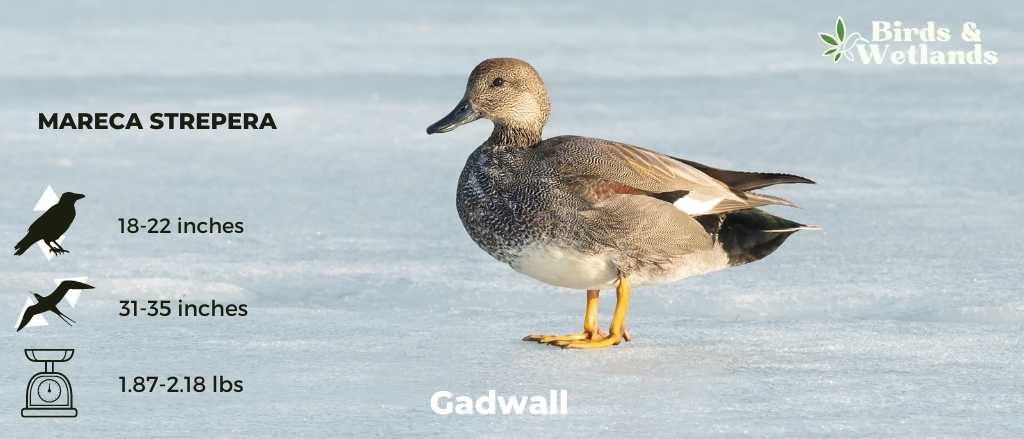The gadwall is a dabbling duck common throughout the northern hemisphere. It is a medium-sized duck found in marshes, ponds, and other wetland habitats.
The gadwall breeds in the northern parts of the Palearctic and Europe and central parts of North America.
Scientific Name: Mareca strepera
Height: 46–56 cm (18–22 in)
Wingspan: 78–90 cm (31–35 in)
Weight
Gadwall Description
The male gadwall has a medium build, mostly grey-brown with white underparts and a black rump. The speculum (a white patch on the wings) and black portions on the wing converts are visible in flight, and the bird has black and white markings on its upper breast and flanks. It has white belly and black rear-end.
The head is brown with a cinnamon wash on the forehead and chin, and the bill is slate-grey. The eyes are dark gray-brown, and the legs and webbed feet are yellowish-orange. The tail is pale greyish with black uppertail and undertail-coverts.
Male gadwalls lack the colorful plumage of most male ducks. Nonetheless, their appearance is unmistakable.
The female gadwall has a mostly mottled brown and buff plumage that is heavily scalloped darker, mainly on the flanks. She has a smaller white speculum than males, and her chin and upper breast are paler than the male. Her bill is yellowish with dark spots, thinner and darker than the female mallard’s.
The male in winter or eclipse plumage looks similar to the female and non-breeding male.

Listen to Gadwall
Gadwall Habitat & Range
Gadwalls inhabit a variety of wetland habitats, including lakes, marshes and sewage ponds. They are found throughout the United States and Canada, wintering in the southern parts of both countries.
Gadwalls can also be seen in Europe and parts of Asia during migrations. Some birds can be found year-round in certain areas if food remains abundant but most gadwalls can be found wintering north of the tropics.
Gadwalls are also found in parts of Africa and South America, but these birds are believed to have been introduced from North America.

Gadwall Diet & Food Habits
Gadwalls are mainly herbivores, foraging on the surfaces of wetlands and dabbling with head submerged in shallow water. Their preferred diet consists of aquatic plants, seeds, and insects. Occasionally, they supplement their diet with invertebrates such as midges, mayflies, dragonflies, and beetles.
Small flocks might feed on grain or other plant materials during the migration or in wintering habitats. Some gadwalls can be seen feeding in deeper water than most other ducks.
During the fall migration, these ducks steal food from diving ducks such as coots.

Gadwall Nesting & Mating Habits
The breeding season of the gadwall usually starts in early April and lasts until late July.
The male may engage in one courtship display during the mating season. The female selects the nest site, typically in a marsh or wetland near water surrounded by dense weeds and builds a shallow bowl made from soft plant materials and lined with downy feathers from her breast.
The female lays between 7 to 13 creamy white eggs, which she incubates alone for 24 to 27 days until hatching. Like most ducks, young gadwalls can search for their own food upon hatching.

Gadwall Population & Conservation Status
Gadwalls are abundant, with a stable population worldwide. They are not currently listed as threatened or endangered by the IUCN Red List of Threatened Species.
However, their habitats may be at risk due to agricultural and urban development, which can lead to water pollution and the destruction of wetlands. Conservation efforts such as wetland protection and restoration are essential for their survival.
Gadwall Hunting
Gadwalls are hunted in parts of the United States, including California, Texas and Wisconsin. The season for hunting gadwalls typically begins in late September and lasts through early February. They are among the most hunted duck species, third only to mallards and the green-winged teal.
Hunters must possess a valid state or federal waterfowl stamp plus an appropriate state hunting license. All hunters should follow applicable regulations regarding bag limits, as well as laws and regulations about the use of firearms in hunting.

Key Points
- The gadwall is a dabbling duck that feeds on plants and aquatic invertebrates together with other dabbling ducks.
- Female gadwalls choose the nesting site upon arriving on their breeding grounds.
- Males have a white wing patch which is visible in flight.
- Females incubate the eggs alone.

